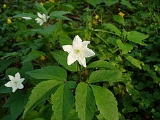
Anemone trifolia
Encyclopedia
Anemone trifolia is a perennial herbaceous plant in the genus Anemone
(Ranunculaceae
).
growing 10–30 cm tall and bear single, white (rarely pale pink or pale bluish) flower
s two centimetres in diameter, with five to nine (most often six) elliptical tepals. The fruit is a cluster of 2 mm achene
s. Its leaves
are divided into three lanceolate leaflets and form a single whorl of three leaves per stem; the leaflets have a toothed but not lobed margin. The rhizome
, found directly below surface is whitish, and tends to form dense clonal colonies
. In subsp. albida, the achenes are pendulous. The species differs from A. nemorosa in its white or pale blue anthers (unlike the yellow anthers of A. nemorosa) and simple lanceolate leaflets lacking the deep lobing of A. nemorosa. The flowering period extends from April through June.
, but has a more restricted range in southern and central Europe
, from Portugal
and Spain
east to Hungary
, and locally north to Finland
, where one small population occurs.
Anemone
Anemone , is a genus of about 120 species of flowering plants in the buttercup family Ranunculaceae in the north and south temperate zones...
(Ranunculaceae
Ranunculaceae
Ranunculaceae are a family of about 1700 species of flowering plants in about 60 genera, distributed worldwide....
).
Description
The plant has stemsPlant stem
A stem is one of two main structural axes of a vascular plant. The stem is normally divided into nodes and internodes, the nodes hold buds which grow into one or more leaves, inflorescence , conifer cones, roots, other stems etc. The internodes distance one node from another...
growing 10–30 cm tall and bear single, white (rarely pale pink or pale bluish) flower
Flower
A flower, sometimes known as a bloom or blossom, is the reproductive structure found in flowering plants . The biological function of a flower is to effect reproduction, usually by providing a mechanism for the union of sperm with eggs...
s two centimetres in diameter, with five to nine (most often six) elliptical tepals. The fruit is a cluster of 2 mm achene
Achene
An achene is a type of simple dry fruit produced by many species of flowering plants. Achenes are monocarpellate and indehiscent...
s. Its leaves
Leaf
A leaf is an organ of a vascular plant, as defined in botanical terms, and in particular in plant morphology. Foliage is a mass noun that refers to leaves as a feature of plants....
are divided into three lanceolate leaflets and form a single whorl of three leaves per stem; the leaflets have a toothed but not lobed margin. The rhizome
Rhizome
In botany and dendrology, a rhizome is a characteristically horizontal stem of a plant that is usually found underground, often sending out roots and shoots from its nodes...
, found directly below surface is whitish, and tends to form dense clonal colonies
Clonal colony
A clonal colony or genet is a group of genetically identical individuals that have grown in a given location, all originating vegetatively from a single ancestor. In plants, an individual in such a population is referred to as a ramet...
. In subsp. albida, the achenes are pendulous. The species differs from A. nemorosa in its white or pale blue anthers (unlike the yellow anthers of A. nemorosa) and simple lanceolate leaflets lacking the deep lobing of A. nemorosa. The flowering period extends from April through June.
Gallery
Distribution
This plant is very similar to A. nemorosaAnemone nemorosa
Anemone nemorosa is an early-spring flowering plant in the genus Anemone in the family Ranunculaceae, native to Europe. Common names include wood anemone, windflower, thimbleweed and smell fox, an allusion to the musky smell of the leaves...
, but has a more restricted range in southern and central Europe
Europe
Europe is, by convention, one of the world's seven continents. Comprising the westernmost peninsula of Eurasia, Europe is generally 'divided' from Asia to its east by the watershed divides of the Ural and Caucasus Mountains, the Ural River, the Caspian and Black Seas, and the waterways connecting...
, from Portugal
Portugal
Portugal , officially the Portuguese Republic is a country situated in southwestern Europe on the Iberian Peninsula. Portugal is the westernmost country of Europe, and is bordered by the Atlantic Ocean to the West and South and by Spain to the North and East. The Atlantic archipelagos of the...
and Spain
Spain
Spain , officially the Kingdom of Spain languages]] under the European Charter for Regional or Minority Languages. In each of these, Spain's official name is as follows:;;;;;;), is a country and member state of the European Union located in southwestern Europe on the Iberian Peninsula...
east to Hungary
Hungary
Hungary , officially the Republic of Hungary , is a landlocked country in Central Europe. It is situated in the Carpathian Basin and is bordered by Slovakia to the north, Ukraine and Romania to the east, Serbia and Croatia to the south, Slovenia to the southwest and Austria to the west. The...
, and locally north to Finland
Finland
Finland , officially the Republic of Finland, is a Nordic country situated in the Fennoscandian region of Northern Europe. It is bordered by Sweden in the west, Norway in the north and Russia in the east, while Estonia lies to its south across the Gulf of Finland.Around 5.4 million people reside...
, where one small population occurs.

